
75
Journal of Development and Integration, No. 78 (2024)
K E Y W O R D S A B S T R A C T
Influencer,
Consumer Behavior,
Purchase Decision.
Over the last several years, influencer marketing has been enjoying a surge in popularity,
and it is anticipated that it will become the marketing approach of choice for the subsequent
years of the 21st century. When it comes to influencer marketing, previous research has
mostly concentrated on identifying influencers and determining whether or not they are
seen to be trustworthy. In order to be influential and to determine whether or not the
influencer is capable of promoting the product to the target audience in an appealing
manner, it is necessary for there to be a match between consumers and influencers in the
field of marketing. Using quantitative empirical research, we conducted a survey over
200 people to determine how they evaluate the experience of a particular influencer. It
provides theoretical and practical implications for the effectiveness of influencer marketing
strategies. Marketers can make informed decisions on which influencers to collaborate
with and how to tailor their campaigns for maximum impact. Additionally, the research
findings can also help influencers themselves understand the factors that contribute to
their success, guide them in building stronger relationships with their audience, expand
their understanding of influencer marketing, and emphasize its role in driving consumer
behavior.
Influencer marketing and purchase intention
Do Phuong Anh, Ton Nu Ngoc Han, Huynh Chau Thuy Tien *
International University, Viet Nam National University Ho Chi Minh City, Vietnam
* Corresponding author. Email: hcttien@hcmiu.edu.vn
https://doi.org/10.61602/jdi.2024.78.10
Received: 26-Feb-24; Revised: 03-Apr-24; Accepted: 22-Apr-24; Online: 26-Jul-24
ISSN (print): 1859-428X, ISSN (online): 2815-6234
1. Introduction
Social media’s fast growth has allowed firms
to reach a wider audience and influence customer
behavior via influencer marketing. Pradhan et al.
(2016) noted that social media influencers are
becoming a crucial part of corporate marketing
efforts. Venciute et al. (2023) define influencers
as social media users with a large following who
promote brands and services. The growth of
Instagram, YouTube, and TikTok has allowed
influencers to reach millions of people worldwide.
For companies looking to grow their consumer
base and reach, influencer marketing has become
popular. Numerous research have examined how
influencer marketing influences customer behavior
and purchases. Venciute et al. (2023) used a
unique technique to investigate influencer-follower
relationships, focusing on trust and experience.
They found that experience and trustworthiness
strongly affected customer trust and purchase
intention. Another research by Nguyen et al. (2022)
No. 78 (2024) 75-85 I jdi.uef.edu.vn

Journal of Development and Integration, No. 78 (2024)
76
examined how social media influencers affected
GenZ consumers’ purchase intentions. They
found that peer evaluations and recommendations
regarding the influencer strongly affected consumer
and purchase inclinations.
Venciute et al., (2023) said the research’s results
on purchase intentions may be inaccurate owing to the
small sample size and the respondents’ backgrounds,
mostly young individuals with minimal financial
capabilities. As advised by Venciute et al. (2023)
and Nguyen et al. (2022) for more reliable results,
future research should involve more customers and
age cohorts. Additionally, questionnaire replies
were typically based on respondents’ shopping
experiences, which may have influenced their
impressions and purchasing intentions. This may
raise response bias and drastically influence results.
Therefore, the authors suggested that future research
include more customers and age cohorts to better
understand purchase intentions.
The findings of the study revealed a robust
correlation between influencers and consumers. The
research additionally indicated that the efficacy of
influencer marketing in shaping consumer purchasing
behavior is contingent upon the alignment between
the influencer and their followers. These findings
are innovative and contribute to the existing body of
knowledge on influencer marketing by examining the
alignment between influencers and their followers
and their purchase patterns. This study sheds
light on the efficacy of influencer marketing and
provides practical recommendations for marketers
in formulating effective influencer marketing
strategies. This study enhances understanding of
influencer marketing for Generation Z individuals
aspiring to become future influencers. Moreover, it
is imperative for personnel inside agency firms to be
abreast of the advancements in influencer marketing
to come up with an effective marketing strategy.
2. Literature Review
2.1. Social media influencer
As mentioned by Felix et al. (2017), Social media
marketing is a multisectoral and multifunctional
approach that uses social network platforms to deliver
value to stakeholders and achieve organizational
goals. It is now recognized as a multidisciplinary
and collaborative approach that utilizes social
media platforms, often in combination with other
communication channels, to achieve organizational
objectives by providing value to stakeholders (Felix
et al., 2017). Traditional communication channels
are becoming obsolete, and businesses need to adopt
digital and social media marketing strategies to
maintain and expand their market share. According
to Tuten and Solomon (2018), Social media
marketing allows businesses to advertise their
products and services on various online platforms
and websites, enhancing their brand identity and
gaining customer favor (e.g., Instagram, Facebook,
TikTok).In addition to existing marketing strategies,
businesses must consider new marketing strategies
and consumer value propositions, such as value,
brand equity, and relationship equity (Shamsudeen
Ibrahim, 2018). Social media influencers possess
expertise in certain areas and gain a following due
to the specialized material they provide (Lou &
Yuan, 2019). However, celebrities can be considered
endorsers if they consistently build viral content on
social networks (Campbell & Farrell, 2020).
2.2. Influencer marketing
Influencer marketing is a new marketing
strategy that involves opinion leaders influencing
consumer purchasing choices and brand awareness.
Companies are increasingly using this strategy to
promote their products through impactful social
media content (Giles & Edwards, 2018). Influencers’
recommendations are crucial when comparing
products and making purchasing decisions, as
their followers trust them (Boerman, 2020; Lou &
Yuan, 2019; Stubb & Colliander, 2019). Influencers
create and promote sponsored content through their
personal social media channels, and they review the
brand by providing information about the product
and sharing their personal experiences (Lou &
Yuan, 2019; Stubb & Colliander, 2019). Lou & Yuan
(2019) defined an influencer as a content generator
with expertise in a specific area and a large number
of captive followers who are of marketing value to
brands. When choosing influencers, marketers must
consider the size of the audience and the qualities
of the audience. Influencers can be classified into
mega, macro, micro, and nano influencers, as well
as celebrities, macro-influencers, professionals,
micro-influencers, and nano-influencers (Campbell
& Farrell, 2020)
Do Phuong Anh et al.

77
Journal of Development and Integration, No. 78 (2024)
2.3. The relevance of credibility
The credibility model (Hovland & Weiss, 1952)
suggests that receiving information from trustworthy
sources can influence consumer attitudes and
perceptions about endorsements (Erdogan, 1999).
Credible influencers, perceived as having higher levels
of competency and dependability, can significantly
impact purchasing behavior and willingness in target
groups. Previous research has studied credibility as
a one and multidimensional reality, with this study
focusing on three aspects: competence (experience),
trustworthiness (credibility), and relevance of
products and targeted consumers, as well as peer
review. This multidimensional approach helps
understand the impact of credibility on consumer
behavior and willingness.
2.4. Experience
Competence in influencer communication
refers to a communicator’s level of experience and
knowledge in a subject matter. It is a reliable source
of information and often derived from knowledge,
experience, or training (Erdogan, 1999). According
to (Lou & Yuan, 2019), consumers often consult
online reviews and suggestions before making
purchases, and influencers often have knowledge
in specific fields. Elwalda & Lu (2016) pointed out
that Consumers examine suggestions and advice
they find online before making purchases, but they
are more inclined to believe recommendations from
influencers they see as knowledgeable. As a result,
they must be viewed as robust sources of information
when influencing followers’ point of view and
behaviors. Consumers often rely on the opinions of
authority figures, leading to favorable attitudes and
purchase intentions towards the product or brand
being sold (Ohanian, 1990).
H1: The experience of influencer directly and
positively affects the purchasing behavior of their
followers.
2.5. Trustworthiness
Credibility, as defined by Ohanian (1990), is the
truthfulness, reliability, and accuracy of an endorser.
Trust, as highlighted by Lee & Koo (2015), is crucial
for influencers to influence consumers. Consumers
seek information from others to minimize perceived
risks and boost confidence in online transactions.
Trust is a key factor in e-commerce, as buyers are
less likely to trade online if they don’t trust the
vendor. A positive attitude towards transaction
behavior, leading to transaction intention, can be
generated through trust.
H2: An influencer’s trustworthiness directly
influences the purchasing behavior of their followers
in a positive way.
2.6. The relevance of products and targeted
consumer
Research shows that aligning brands with
influential figures who share similar lifestyles,
personality traits, and behavioral preferences can
enhance brand trust and improve purchase intention
(Choi & Rifon, 2012; Nam & Dân, 2018; Zietek,
2016). This is particularly important for brands
with unique products and services, as customers
often follow influencers with similar behaviors (Xu
(Rinka) & Pratt, 2018), which is the initial step in
establishing a connection between influencers and
followers.
H3: The relevance of product and consumers
of an influencer positively and directly influence
purchase behavior of followers.
2.7. Peers’ review and recommendation
In today’s technologically advanced world,
consumers constantly exchange information with
their peers due to the ease and speed of sharing
information on social media (Kitchen & Proctor,
2015). Cruz (2016) suggests that we should focus
on igniting brand dialogues among customers’
communities and providing reliable, genuine advice
about influencers. Peer recommendations and
opinions about influencers have been identified as a
factor affecting consumer purchase intention, rather
than direct information from influencers (Cruz,
2016; Lu et al., 2014; Momtaz et al., 2011).
H4: A review conducted by peers on social media
has a positive and direct impact on the purchasing
behavior of followers.
2.8. Influencer-follower congruence
The term “congruence” has been sparingly
used by a small number of scholars in the field of
Do Phuong Anh et al.

Journal of Development and Integration, No. 78 (2024)
78
marketing. Alternatively, according to (Malär et al.,
2011), authors imparted it in other terms such as
suitable, correspondence, match-up, or typicality.
To be in line with (Kamins & Gupta, 1994; Till &
Busler, 2000), the perceived the combination of the
celebrity and the brand is a positive determinant
for a convenient match-up. The particular studies
demonstrate that the selection of a celebrity endorser
is significant for corporations and brands, since it
may directly influence the efficacy and triumph of
the advertisement or campaign (e.g., Venciute et al.,
2023). A strong connection between the brand and
the influencer plays an important role in the success
of the advertising. Given the fact that social network
endorsers are often viewed as more trustworthy,
authentic, and sincere than individuals promoting
other products or services.
H1a: Agreement between influencers and their
followers, the association between influencer’s
perceived experience and purchasing behavior
is enhanced by a positive moderating effect.
Specifically, when followers align with an influencer,
the experience of influencer has a greater impact on
their purchasing behavior.
H2a. The connection between perceived
trustworthiness of an influencer and purchase
behavior is positively affected by the resemblance
between the influencer and their followers. This
means that when followers are in alignment with an
influencer, the trustworthiness of the endorser has a
greater effect on their purchasing behavior.
H3a. Agreement between influencers and their
followers, the presence of a positive moderator
enhances the connection between the perceived
relevance of products and consumers by influencers
and buy behavior. Specifically, when followers
align with an influencer, the influencer’s relevance
of products and consumers has a stronger effect on
their purchase behavior.
H4a. The congruence between influencers and
their followers has a positive effect on the relationship
between the perceived relevance of social media
reviews and purchase behavior. Specifically, the
impact of influencer social media review relevance
on purchasing behavior is stronger when followers
are cohered to the influencer.
2.9. Underpinning theory and the conceptual
framework
Social Identity Theory, developed by Tajfel
& John (1970), is a framework that examines the
relationship between influencer marketing and
purchase intention. The components of Social Identity
Theory might be considered crucial catalysts for the
achievement of influencer marketing success. In the
realm of influencer marketing, followers establish
a sense of affiliation with the influencer, seeing
them as members of their social circle. Successful
endorsement outcomes occur when there is a
significant resemblance between the social media
influencer’s image and the intended self-image of
the customer.
The study applies Social Identity Theory to
investigate the impact of connection between
influencers and followers on the relation of
influencer marketing and purchasing behavior.
The new conceptual framework adopted by studies
of both Nguyen et al. (2022) and Venciute et al.
(2023) will be used to investigate the effect of this
congruence on followers’ perceptions of influencers’
experience, trustworthiness, product and consumer
relevance, and peer reviews.
The study applies Social Identity Theory to
investigate the impact of connection between
influencers and followers on the relation of influencer
marketing and purchasing behavior. In particular,
we examine how Experience and Trustworthiness,
as components of Social Identity Theory, might be
used to forecast purchase intention. Previous studies
have examined the role of perceived trustworthiness
in influencing consumers’ future behaviors and have
shown encouraging outcomes, such as an increase
in customer purchase intention (e.g., Chu & Kamal,
2008; Dimitrova & Rosenbloom, 2014). According
to (Bergkvist et al., 2016), expert influencers, who
possess specialized knowledge, play a crucial role
in establishing relationships and trust with their
followers. These influencers have the ability to
affect consumers’ attitudes and behaviors towards
businesses and may even initiate positive actions
towards the company. Moreover, Chua & Banerjee,
(2015) and Floh et al. (2013) and Zhu et al. (2010)
assert that buyers are actively striving to ascertain
the quality of products by checking reviews.
Consumer review systems may optimize the ratio
of perceived advantages and quality of items, hence
influencing consumer purchase choices (Goldsmith
and Horowitz, 2006). In this context, we consider
professional influencers to be a significant resource
Do Phuong Anh et al.

79
Journal of Development and Integration, No. 78 (2024)
for product evaluations and endorsements. Through
using their specialized knowledge, these influencers
are able to provide perceptive and reliable
evaluations of different companies, enabling
customers to make well-informed choices when
buying. Moreover, the impact of skilled influencers
goes beyond mere product endorsements. In
addition, they have the ability to influence customer
views and attitudes towards companies, therefore
establishing a favorable reputation and fostering
brand loyalty within their audience (Constantinides
& Holleschovsky, 2016).
The research aims to investigate the impact of
influencer-follower congruence on the efficacy of
influencer marketing campaigns. It will examine
the extent to which similarities in terms of values,
interests, demographics, or other characteristics
between influencers and their followers affect
campaign outcomes. According to (Nguyen
et al., 2022; Venciute et al., 2023), the new
conceptual framework is adopted. Our objective
is to investigate the effect of this congruence on
followers’ perceptions of influencers’ experience,
trustworthiness, product and consumer relevance,
and peer reviews. Ultimately, we want to understand
how this influence affects their purchasing behavior
(see Figure 1).
The conceptual model is presented in Figure 1.
2.10. Methodology
This study utilized a quantitative method
to conduct market research and gain a deeper
understanding of the relationship between influencers
and purchasing behavior. A random sample of
data was collected through an online survey using
Google Forms. Previous studies conducted by
Venciute et al. (2023) focused on an Instagram
influencer with a large following and the interaction
between the influencer and her followers. The target
demographic of Nguyen et al. (2022) for the survey
was Generation Z and Generation Y, who are aware
of the significance of influencers in their purchase
decisions. Convenience sampling was used to collect
data, and various social networking sites were used
to establish communication with participants (e.g.,
Facebook, Zalo, and TikTok).
In this study, the researchers developed a scale
based on previous research conducted by Venciute
et al. (2023) and Nguyen et al. (2022). The scale
Figure 1. The conceptual frameworkadopted from (Venciute et al., 2023) (Nguyen et al., 2022)
Do Phuong Anh et al.


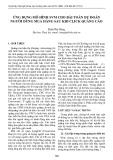
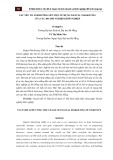
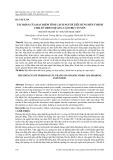
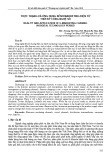

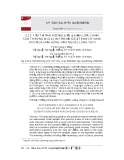
















![Phát triển ý tưởng kinh doanh: Bí quyết khởi nghiệp thành công [2024]](https://cdn.tailieu.vn/images/document/thumbnail/2025/20251225/tangtuy08/135x160/954_bai-giang-phat-trien-y-tuong-khoi-nghiep-truong-dh-thuong-mai.jpg)

